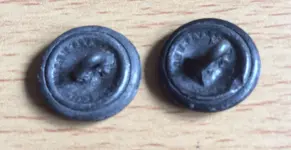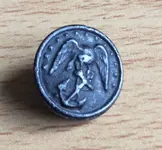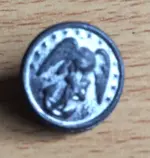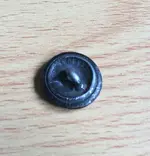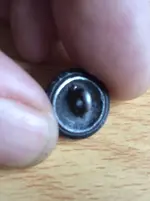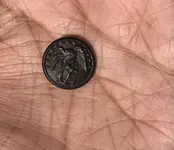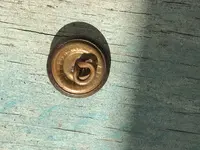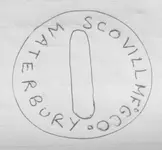I think we can discover the correct answers to the mysteries. That is my only goal.
First, you asked how old they are. A key clue to that answer is the fact that you report their size (diameter) as approximately 5/8-inch. According to the book "Record Of American Uniform And Historical Buttons (by Alphaeus H. Albert), in the 20th Century "the Regulations of the US Marine Corps specify three sizes of buttons for officers, namely 1&1/8" (28.5mm), 1" (25.4mm), 27/40" (17mm), and four sizes for the enlisted men, namely 1&1/8" (28.5mm), 7/8" (22mm), 3/4" (19mm) and 5/8-inch (16mm)."
Since you say your two US marines buttons measure approximately 5/8th-inch, they are from the 20th Century, not any earlier. Also, the Scovill Manufacturing Company stopped making buttons in 1962.
I need you to use a Digital Caliper to measure them super-precisely, to tell with certainty whether they are 5/8" (16mm) for enlisted men, or the 17mm size for officers. The difference is important, because according to the Official Regulations, enlisted-men's button were NOT to be gilded or plated... ONLY a simple "bronze finish."
If they are indeed the 5/8" (16mm) size specified in the Regulations for enlisted-men's uniform... the "bronze finish" Regulation is why I find it difficult to believe your buttons are made of something other than brass/bronze. How could a "bronze finish" be put on a pewter or "base metal" button? And, why go to that extra effort and expense, instead of simply making the buttons from brass/bronze in the first place?
Jedifelix17 says that one of the buttons apperars to be silverplated. I have never seen any report of silverplated US Marines buttons. The Official Regulations do not authorize such a thing... specifying only either gilt (goldplating) for officer buttons, and "bronze finish" for enlisted-men's buttons.
I've saved what may be the most important observation for last. Your photos show that EVERY COMPONENT of those two US Marines buttons (front, back, wire-loop, and solder/brazing) is the same color. Ordinarily, that sameness-of-color can have only one cause: (1) all the components are made of the same material, (2) paint or "finish" (such as the WW1 camouflage "black finish") of some kind has been applied to all of the components, (3) the components have been electroplated some time AFTER the button was manufactured.
Please note, from the manufacturer's viewpoint there is no need to electroplate the wire loop on the button's back. I've seen some historical American Military (US and State Militia) buttons which have a silverplated front and back, but the wire loop and the solder/brazing which attaches the loop to the button's back is NEVER plated. That is a waste of the expensive "precious metal" used for plating.
The only reason I can think of for every component of Jedifelix17's buttons being the same color is that somebody (not the manufacturer) electroplated them, probably long after they were originally manufactured.
There is a test to tell with certainty whether those Scovill-produced US Marines buttons are made of brass/bronze, or a "white" metal such as pewter or zinc or base-metal... but it is "destructive" in a small way. Made a tiny gouge (not just a shallow scrape) by using a hacksaw blade on the back edge of the button, with the requirement that it must go deep enough to penetrate any plating or applied "finish." I won't hold it against you if you are not willing to do that... but it would settle the question of what type of metal the button's body is made of. It would also allow you to have the button tested to see whether the color is silverplate, or Sterling Silver, or something else.




